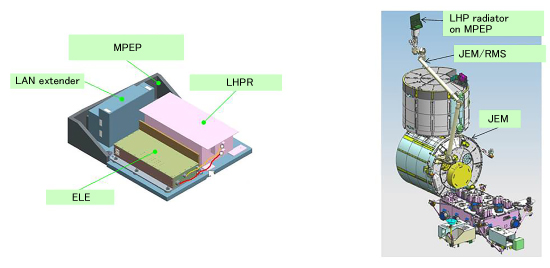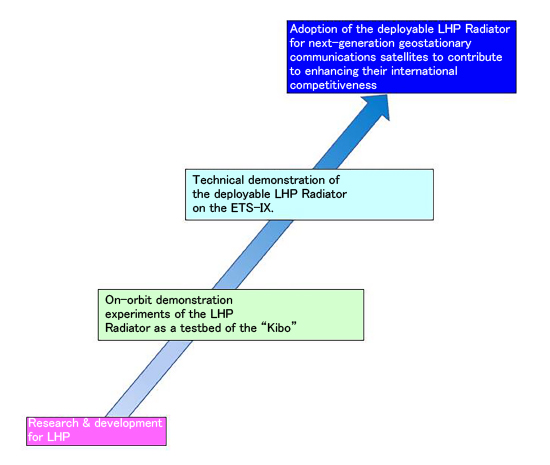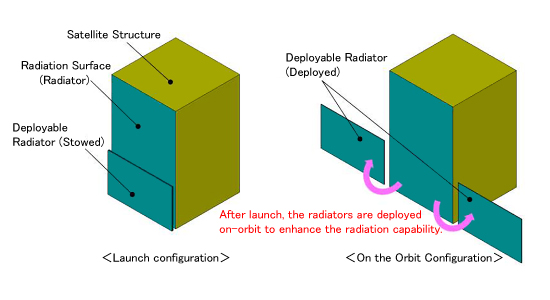This is an archive of information released in the past.
Disclaimer: It may contain broken links or outdated information. Some parts may not function in current web browsers.
*Visit https://humans-in-space.jaxa.jp/en/ for the latest information.

H-II Transfer Vehicle KOUNOTORI (HTV)
On-orbit demonstration experiments for thermal control technologies required for implementing competitive next-generation geostationary communications satellites
JAXA is currently committed to enhancing the international competitiveness of space industries with a view to realizing an internationally competitive satellite system on the fiercely competitive market of commercial communications satellites in the 2020s. For this purpose, JAXA’s three directorates — Research and Development Directorate, Human Spaceflight Technology Directorate and Space Technology Directorate I — will for the first time coordinately work and utilize the Japanese Experiment Module “Kibo” as a testbed for satellites development and carry out on-orbit demonstration for the required advanced heat rejection technologies.
Advanced heat rejection technologies required for implementing competitive next-generation geostationary communications satellites
Next-generation geostationary communications satellites will require a large increase in number of transponders in order to ensure international competitiveness. Thus, such satellites will need a technology for increasing the electric power supplied to communications payload and a technology for large quantities of heat rejection. The traditional method to meet these requirements has been to increase the overall dimensions of a satellite to ensure large radiation surfaces (radiators). However, this method has the restriction that every satellite must be constructed in such dimensions that allow it to be housed in the rocket’s fairing. A method that JAXA plans to apply for considerably improving a satellite’s heat rejection capability is based on a deployable radiator that can be deployed from a satellite on orbit after launch.

Configuration of Loop Heat Pipe Radiator (LHPR) on Multi-Purpose Experiment Platform (MPEP) and On-orbit experiment position and attitude (Credit: JAXA)
Organizational coordination in JAXA for application of deployable LHP radiator
The deployable radiator system based on Loop Heat Pipe (LHP) is capable of efficiently heat transfer from the structure of a satellite containing various electrical devices to distant points of the deployable radiators. Before it becomes possible to equip a next-generation geostationary communications satellite with LHP-based deployable radiator (DPR), technical demonstration experiments must be carried out on the Engineering Test Satellite ETS-IX. Before installing DPR on the ETS-IX, the JEM “Kibo” will be used to carry out on-orbit demonstration experiments on LHP radiator (LHPR) to make sure that they are able to correctly behave in the microgravity environment as expected. The KOUNOTORI 7 (HTV7), cargo transfer vehicle to the International Space Station (ISS), will carry LHPR for on-orbit demonstration experiment. These LHPR will firmly be attached to the tip of the Kibo’s Remote Manipulator System (JEMRMS) to undergo on-orbit demonstration experiments for about one month. All results to be thus obtained from these experiments will be considered in the development activities for DPR on the ETS-IX to reduce the technical risks during satellite development. These demonstration experiments on the ETS-IX will be followed by actual installation of DPR on next-generation geostationary communications satellites. For the first time in JAXA’s history, the technologies developed by the Research and Development Directorate to be used for the satellite being developed by the Space Technology Directorate I are utilized by the Human Spaceflight Technology Directorate in demonstration experiments using the JEM “Kibo.”
【Reference】For details on LHP as an advanced thermal control device, visit Website of the Research and Development Directorate (Japanese page)
【Reference】For details on the Engineering Test Satellite ETS-IX, visit Website of the Space Technology Directorate I. (Japanese page)

Sequence of Development of JAXA’s Deployable LHP Radiator (Credit: JAXA)
| Copyright 2007 Japan Aerospace Exploration Agency | Site Policy |
